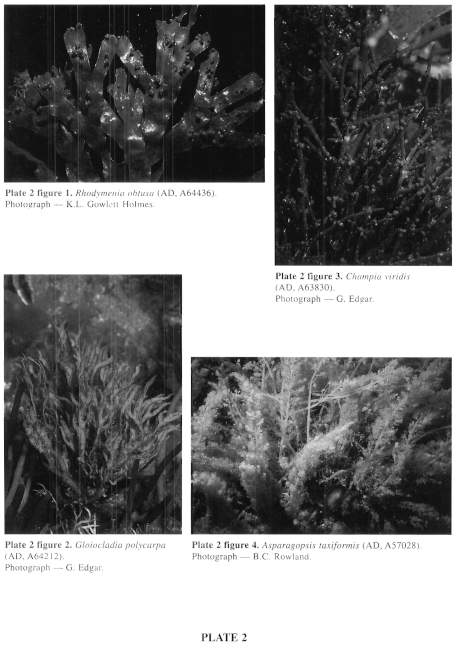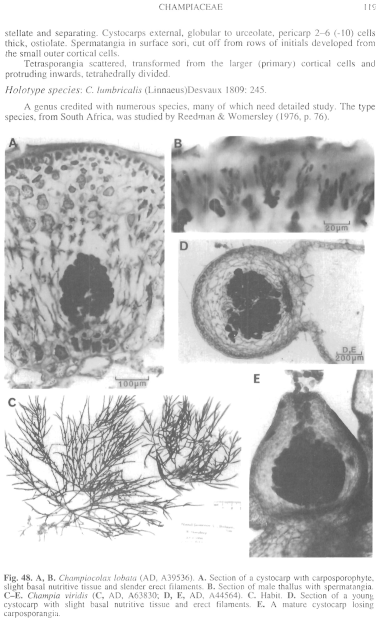|
|
|
|
|
|||||||||||
|
Electronic Flora of South Australia Species Fact Sheet
Phylum Rhodophyta – Class Florideophyceae – Order Rhodymeniales – Family Champiaceae
Selected citations: Huisman & Walker 1990: 415. Kützing 1849: 862. Millar & Kraft 1993: 30. Reedman & Womersley 1976: 77, figs 1, 2A–D, 10.
Synonyms
Corinaldia viridis (C. Agardh) Trevisan 1848: 108.
Champia tasmanica Harvey 1844a: 407, pl. 19; 1849: 78; 1859b: 307. J. Agardh 1852: 370; 1876: 306; 1879: 67, pl. 19 figs 10–12. De Toni 1900a: 79; 1900b: 563. Guiler 1952: 95. Hooker & Harvey 1847: 402. Kützing 1849: 861; 1865: 30, pl. 84g. Kylin 1931: 29. Lucas 1929b: 50. Lucas & Perrin 1947: 207, fig. 72. May 1965: 362. Reinbold 1897: 53; 1899: 45. Sonder 1846: 177(?); 1881: 17. Tisdall 1898: 506. Wilson 1892: 180. Womersley 1950: 174; 1966: 151.
C. tasmanica var. gracilis Harvey 1863, synop.: xxvii. Sonder 1881: 17.
Corinaldia tasmanica (Harvey) Trevisan 1848: 108.
Champia oppositifolia J. Agardh 1901: 27. Kylin 1931: 29, pl. 16 fig. 37. May 1965: 362.
Champia verticillata J. Agardh 1901: 26. Kylin 1931: 29, pl. 17 fig. 39. May 1965: 362.
Champia compressa sensu Harvey 1863, synop.: xxvii (in part).
Thallus (Fig. 48C) dark-red to red-purple, 5–15 (–20) cm high, densely tufted, axes (1–) 2–3 mm broad, with numerous branches for 2–4 orders, irregular, sub-opposite or verticillate. Branches terete to slightly compressed, (0.5–) 1–1.25 mm broad, linear to slightly curved, basally constricted, apices rounded; diaphragms 0.5–1 (–1.5) mm apart, regular and conspicuous in surface view. Holdfasts small, discoid, on stoloniferous basal branches; epilithic or on Posidonia. Structure multiaxial with central and peripheral initials (Fig. 49B), developing a single-layered cortex (Fig. 49A) of compact, polygonal cells 25–40 µm across with small cells cut off in the outer corners, and in older parts an inner cortex (Fig. 49E) of rhizoidal filaments several filaments thick, derived from the peripheral diaphragm cells; longitudinal filaments (Fig. 49A, D) both peripheral and central with one complete and two part cells between the diaphragms, the central cell bearing a secretory cell; diaphragms (Fig. 49C) monostromatic. Rhodoplasts discoid, in chains.
Reproduction: Gametangial thalli probably dioecious. Carpogonial branches 4-celled, auxiliary cell branches 2-celled, borne on a cortical supporting cell (Fig. 49F) with adjacent cortical cells proliferating. Carposporophyte with a basal branched fusion cell and branched gonimoblast filaments bearing ovoid to angular, terminal to subterminal carposporangia 45–60 µm in diameter; basal nutritive tissue slight, erect filaments slender, cells stellate, conspicuous when young (Fig. 48D). Cystocarps (Fig. 48E) scattered, external, globular to urceolate, 0.5–1 mm in diameter. Pericarp 180–280 µm and 4–6 cells thick, inner cells stellate with long arms, ostiolate. Spermatangia not observed.
Tetrasporangia (Fig. 49G) scattered, transformed from cortical cells, 60–90 (–120) µm in diameter, tetrahedrally divided.
Type from W. Aust.; holotype (mica mounts) in Herb. Agardh, LD, 26112.
Selected specimens: Fremantle, W. Aust. (Clifton; TCD). Cannan Reefs, S. Aust., 20–25 m deep (Branden, 21.i.1991; AD, A61084). Pearson I., S. Aust., 35 m deep (Shepherd, 7.i.1969; AD, A34040). Stenhouse Bay, S. Aust., 3–7 m deep (Kraft, 18.ix.1973; AD, A44564). Marino, S. Aust., drift on Posidonia (Womersley, 26.x.1975; AD, A46651). Victor Harbor, S. Aust., drift (Womersley, 24.vii.1949; AD, A11183). American R. inlet, Kangaroo I., S. Aust., sublittoral (Womersley, 2.xi.1947; AD, A6168). Pennington Bay, Kangaroo I., S. Aust., 0.5–1 m deep (Kraft, 13.iv.1973; AD, A42998). Cape Lannes, S. Aust., just sublittoral (Reedman, 10.ii.I973; AD, A42991). Nora Creina, S. Aust., just sublittoral (Reedman, 12.ii.1973; AD, A42995). Warrnambool, Vic., 4–5 m deep (Shepherd, 19.viii.1972; AD, A42626). Popes Eye, Port Phillip Heads, Vic., 2 m deep (Macpherson, 5.v.1963; AD, A28822). San Remo, Vic., drift on outer beach (Sinkora A467, 14.vi.1970; AD, A62626). Crawfish Rock, Westernport Bay, Vic., 4–5 m deep (Watson, 26.iv.1969; AD, A34268). Gabo I., Vic., 28 m deep (Shepherd, 19.ii.1973; AD, A43546). Cape Sorell, Tas., low eulittoral (Bennett, 4.ii.1955; AD, A20606). Pilot Station, Low Head, Tas., drift (Womersley, 23.x.1986; AD, A57778). N end Governor I., Bicheno, Tas., 8–16 m deep (Edgar, 23.x.1944; AD, A63830). Stapleton Point, Prosser Bay, Tas., 8–12 m deep (Olsen, 21.vi.1966; AD, A30550). Lady Bay, Southport, Tas., 3–5 m deep (Brown & Womersley, 28.x.1982; AD, A56521).
Distribution: Rottnest I., W. Aust., to Jervis Bay, N.S.W. (Millar & Kraft 1993, p. 30), and around Tasmania.
Taxonomic notes: The synonymy of C. viridis was discussed by Reedman & Womersley (1976, p. 79). It is a distinctive species having central as well as peripheral longitudinal filaments, but specimens from calm water situations are smaller and slenderer than those from rough-water situations.
References:
AGARDH, C.A. (1828). Species Algarum. Vol. 2, pp. 1–189. (Mauritius: Greifswald.)
AGARDH, J.G. (1852). Species Genera et Ordines Algarum. Vol. 2, Part 2, pp. 337–720. (Gleerup: Lund.)
AGARDH, J.G. (1876). Species Genera et Ordines Algarum. Vol. 3, Part 1 — Epicrisis systematis Floridearum, pp. i-vii, 1–724. (Weigel: Leipzig.)
AGARDH, J.G. (1879). Florideernes morphologi. K. Svenska Vetensk. Akad. Handl. 15(6), 1–199, Plates 1–33.
AGARDH, J.G. (1901). Species Genera et Ordines Algarum. Vol. 3, Part 4, pp. 1–149. (Gleerup: Lund.)
DE TONI, G.B. (1900a). Il genere Champia Desv. Mem. Pontif. Accad. Nuovi Lincei, Roma, 17, pp. 65–80.
DE TONI, G.B. (1900b). Sylloge Algarum omnium hucusque Cognitarum. Vol. 4. Florideae. Sect. 2, pp. 387–776. (Padua.)
GUILER, E.R. (1952). The marine algae of Tasmania. Check List with localities. Pap. Proc. R. Soc. Tasm. 86, 71–106.
HARVEY, W.H. (1844a). Champia tasmanica; a new Australian alga. Lond. J. Bot. 3, 407, Plate 19.
HARVEY, W.H. (1859b). Algae. In Hooker, J.D., The Botany of the Antarctic Voyage. HI Flora Tasmaniae. Vol. II, pp. 282–320. (Reeve: London.)
HARVEY, W.H. (1863). Phycologia Australica. Vol. 5, Plates 241–300, synop., pp. i-lxxiii. (Reeve: London.)
HOOKER, J.D. & HARVEY, W.H. (1847). Algae Tasmanicae. Lond. J. Bot. 6, 397–417.
HUISMAN, J.M. & WALKER, D.I. (1990). A catalogue of the marine plants of Rottnest Island, Western Australia, with notes on their distribution and biogeography. Kingia 1, 349–459.
KÜTZING, F.T. (1849). Species Algarum. (Leipzig.)
KÜTZING, F.T. (1865). Tabulae Phycologicae. Vol. 15. (Nordhausen.)
KYLIN, H. (1931). Die Florideenordnung Rhodyméniales. Lunds Univ. Årsskr. N.F. Avd. 2, 27 (11), 1–48, Plates 1–20.
LUCAS, A.H.S. & PERRIN, F. (1947). The Seaweeds of South Australia. Part 2. The Red Seaweeds. (Govt Printer: Adelaide.)
LUCAS, A.H.S. (1929b). A census of the marine algae of South Australia. Trans. R. Soc. S. Aust. 53, 45–53.
MAY, V. (1965). A census and key to the species of Rhodophyceae (red algae) recorded from Australia. Contr. N.S.W. natn. Herb. 3, 349–429.
MILLAR, A.J.K. & KRAFT, G.T. (1993). Catalogue of Marine and Freshwater Red Algae (Rhodophyta) of New South Wales, including Lord Howe Island, South-western Pacific. Aust. Syst. Bot. 6, 1–90.
REEDMAN, D.J. & WOMERSLEY, H.B.S. (1976). Southern Australian species of Champia and Chylocladia (Rhodyméniales: Rhodophyta). Trans. R. Soc. S. Aust. 100, 75–104.
REINBOLD, T. (1897). Die Algen der Lacepede und Guichen Bay und deren näherer Umgebung (Süd Australien), gesammelt von Dr. A. Engelhart-Kingston. Nuova Notarisia 8, 41–62.
REINBOLD, T. (1899). Meeresalgen von Investigator Street (Slid Australien), gesammelt von Miss Nellie Davey (Waltham, Honiton). Hedwigia 38, 39–51.
SONDER, O.W. (1846). Algae. In Lehmann, C., Plantae Preissianae. Vol. 2, pp. 148–160. (Hamburg.)
SONDER, O.W. (1881). In Mueller, F., Fragmenta Phytographiae Australiae. Supplementum ad volumen undecinum: Algae Australianae hactenus cognitae, pp. 1–42, 105–107. (Melbourne.)
TISDALL, H.T. (1898). The algae of Victoria. Rep. 7th Meet. Aust. Ass. Adv. Sci., Sydney, 1898, pp. 493–516.
TREVISAN, V.B.A. (1848). Saggio di una monografia delle alghe cocotalle. (Padova.)
WILSON, J.B. (1892). Catalogue of algae collected at or near Port Phillip Heads and Western Port. Proc. R. Soc. Vict. 4, 157–190.
WOMERSLEY, H.B.S. (1950). The marine algae of Kangaroo Island. III. List of Species 1. Trans. R. Soc. S. Aust. 73, 137–197.
WOMERSLEY, H.B.S. (1966). Port Phillip survey, 1957–1963: Algae. Mem. natn. Mus., Vict. No. 27, 133–156.
The Marine Benthic Flora of Southern Australia Part IIIB complete list of references.
Publication:
Womersley, H.B.S. (28 June, 1996)
The Marine Benthic Flora of Southern Australia
Rhodophyta. Part IIIB. Gracilarialse, Rhodymeniales, Corallinales and Bonnemaisoniales
Reproduced with permission from The Marine Benthic Flora of Southern Australia Part IIIB 1996, by H.B.S. Womersley. Australian Biological Resources Study, Canberra. Copyright Commonwealth of Australia.
Illustrations in Womersley Part IIIA, 1996: PLATE 2 fig. 3; FIGS 48 C–E, 49.

Plate 2 enlarge
PLATE 2
figure 1. Rhodymenia obtusa (AD, A64436). Photograph - K.L.Gowlett-Holmes.
figure 2. Gloiocladia polycarpa (AD, A64212). Photograph - G. Edgar.
figure 3. Champia viridis (AD, A63830). Photograph - G. Edgar.
figure 4. Asparagopsis taxiformis (AD, A57028). Photograph - B.C.Rowland.

Figure 48 enlarge
Fig. 48. A, B. Champiocolax lobata (AD, A39536). A. Section of a cystocarp with carposporophyte, slight basal nutritive tissue and slender erect filaments. B. Section of male thallus with spermatangia. C–E. Champia viridis (C, AD, A63830; D, E, AD, A44564). C. Habit. D. Section of a young cystocarp with slight basal nutritive tissue and erect filaments. E. A mature cystocarp losing carposporangia.

Figure 49 enlarge
Fig. 49. Champia viridis (A, AD, A42995; B–D, AD, A42991; E–G, AD, A30550). A. Longitudinal section of a branch apex showing development of cortex, longitudinal filaments and diaphragms. B. Surface view of branch apex showing central and peripheral apical cells. C. Transverse section of a young branch showing a diaphragm with peripheral and scattered longitudinal filaments. D. Three-dimensional view of branch showing diaphragms and longitudinal filaments with secretory cells. E. Longitudinal section of older branch showing development of central rhizoids from peripheral diaphragm cells. F. Early post-fertilization stage with supporting cell bearing an old carpogonial branch and auxiliary cell branch, with cortical proliferation leading to formation of the pericarp. G. Transverse section of cortex with a mature tetrasporangium. [After Reedman & Womersley 1976.]

|
Email Contact: State Herbarium of South Australia |

|